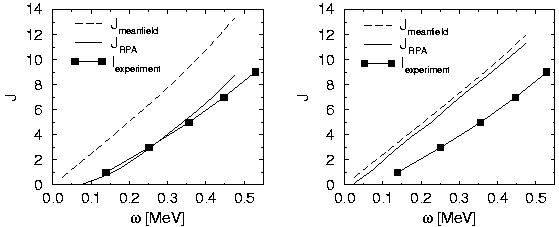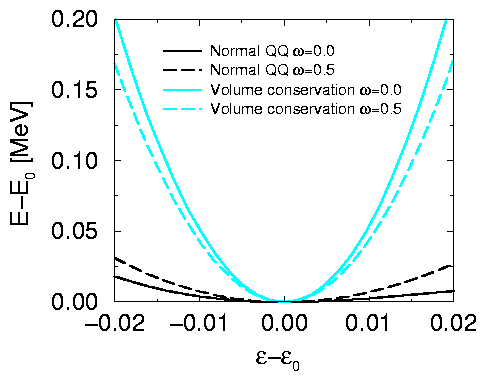| Effects of Quadrupole RPA Correlations in Rotating Nuclei B,W | |||||
|---|---|---|---|---|---|
| D. Almehed, F. Dönau, R.G. Nazmitdinov1 | |||||
|
To study the influence of quadrupole shape vibrations on the rotation we have considered the following cranked Hamiltonian implying a residual isoscalar quadrupole-quadrupole interaction:
The first two terms denote the common spherical oscillator part and the
spin-orbit potential which are chosen such that
the mean field approximation of [^H]¢ leads to the
Nilsson Hamiltonian with the cranking term -w[^J]z.
In a first step of our calculations we determine the selfconsistent
values of the deformation parameters e,g
of the mean field potential as a function of the
rotational frequency w. In the second step the RPA treatment
of the Hamiltonian [^H]¢ is performed. Using the
the spectral function integration method [1] the
RPA correlation energy E¢RPA and their dependence on w
is obtained. This correlation energy contains the effects of the
zero point quantum vibrations about the selfconsistent minimum
of the potential energy surface.
The total angular momentum J can be derived from the canonical relation
J(w) = -dE¢/dw which is valid on mean field as well as on RPA level.
There are two different options to construct the selfconsistent
mean field solutions as the basis of the subsequent RPA calculation.
The mean field approximation can be done straightforwardly with
normal quadrupole operators [^Q]m [2]. Alternatively, when
imposing additionally the constraint of volume conservation then the quadrupole
operators have to be taken with doubly stretched coordinates [3].
In either way it is necessary to include the the DN = ±2 mixing
of oscillator shells caused by the quadrupole operators [^Q]m.
The different possibilities do only slightly change the results of the
mean field calculation but produce rather different effects for the
RPA.

Fig. 1 Angular momentum, in units of (h/2p), of the ground state band in 78Sr. Left panel: calculation with mean field approximation and RPA, respectively, with normal QQ force. Right panel: the same with doubly stretched QQ force. Experimental data are taken from [4].
One notices that the mean field result for the angular momentum J is
practically the same irrespectively whether the volume conservation is fulfilled
or not. The moment of inertia is
given by the ascent of the function J(w). The resulting mean field
value is much larger than the one seen in experiment. This is a well
know result which is due to fact that l2 breaks the local Galilean
invariance.
Concerning the quantum effects taken into account by the RPA
there is a dramatic change when comparing the cases of normal
and doubly stretched QQ-force.
The RPA correlations obtained with the normal QQ-force reduce the moment of
inertia by approximately 30 %.
Applying the volume conservation together with doubly stretched
quadrupole operators one has no reduction of the moment of
inertia. There arises only a constant shift DJ = [1/2](h/2p)
of the angular momentum related to its zero point motion. The better agreement
of the RPA value with the experimental one, obtained for normal QQ-force is accidental.

Fig. 2
Potential energy as a function of deformation with the normal QQ-force
(black lines) and with volume conservation (grey lines). The potential
is plotted for the rotational frequencies w = 0 (solid lines) and
0.5 (dashed lines) MeV.
In Fig.2 the potential energies E(e) = < [^H]¢ > calculated for two frequency values w in mean field approximation are shown as a function of the deformation parameter e. The influence of the RPA correlation on the moment of inertia is determined by potential curvature with respect to e and how the curvature is changing with the rotational frequency. One notices that the normal QQ-force leads to a much softer potential than the one with doubly stretched QQ-force. In addition, the stiffness of the potential increases with w in the first case but decreases in the last case. To investigate these effects in more detail we have also considered a normal quadrupole interaction in which all DN = ±2 matrix elements were neglected, i.e. the mixing between the oscillator mayor shells was omitted. In this approximation the RPA correlation effects of the normal QQ-force become similar to the one with volume conservation. This finding indicates the important role of the DN = ±2 shell mixing which is known to be decisive for the formation of the Giant quadrupole resonances in nuclei. To get a more detailed understanding of the mechanism and the validity of different models in describing the effects of shape vibration in the ground state rotational band a more systematic investigation is necessary. 1 Joint Institute for Nuclear Research, 141980 Dubna, Russia References
[1] F. Dönau et al., Phys. Rev. Lett. 83, 280 (1999)
|
